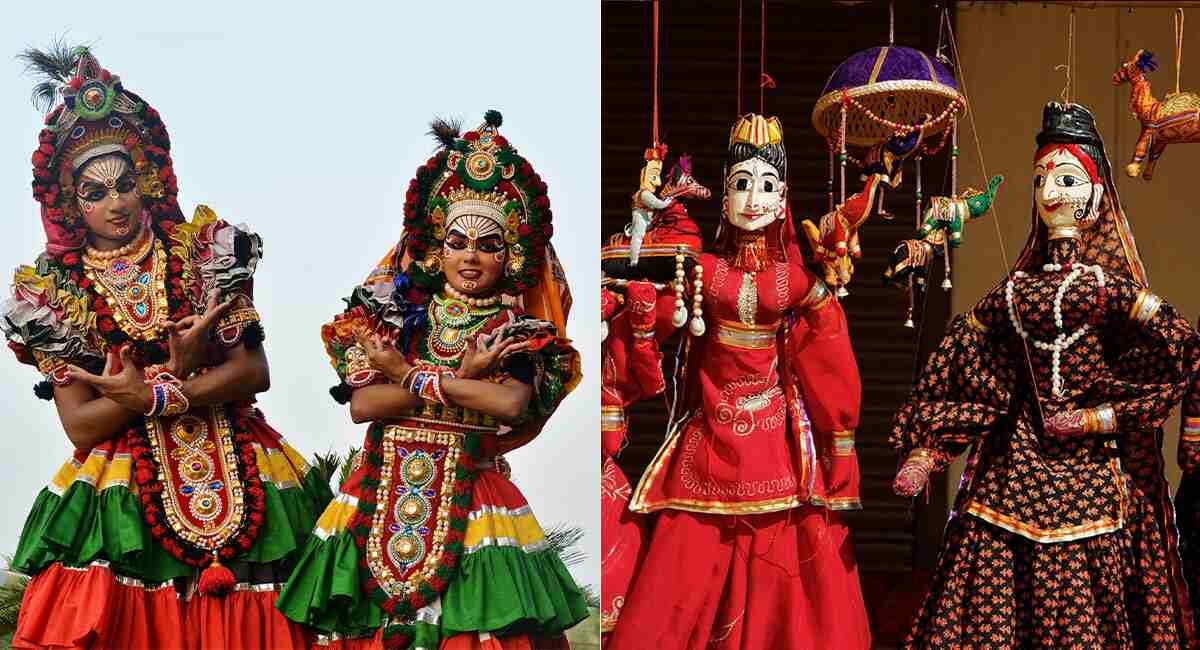Odisha’s Rural Street Performances and Puppet Shows
At the heart of eastern India, Odisha is a land rich in tradition, culture, and heritage. Beyond its renowned temples and classical dance forms, such as Odissi, lies a vibrant world of street performances and puppet shows, especially in rural Odisha, that have been enchanting audiences for generations. These folk traditions are not just entertainment; they are living expressions of the people’s history, social values, and collective imagination.
The Heartbeat of Village Life
In rural Odisha, entertainment has traditionally been a community-based activity. Even today, during festivals, harvest seasons, or village fairs (melas), the entire community gathers in open spaces to witness a variety of street performances and puppet shows. These events are more than leisure activities; they are cultural rituals that reinforce social bonds and celebrate collective identity.
Traditional performers, often traveling artists or local villagers with inherited skills, use music, dance, drama, and storytelling to create mesmerizing shows. These performances are usually impromptu, conducted under open skies, sometimes with minimal props but with maximum passion.
Traditional Street Performances
One of the most popular forms of street performance in rural Odisha is the Pala. In Pala performances, artists sing narratives from ancient texts such as the Mahabharata and the Ramayana, as well as local legends. Accompanied by the mridangam (a percussion instrument) and harmonium, the lead singer — often known as the “Gayaka” — acts as both narrator and performer. In contrast, others form the chorus, responding in musical interludes.
Another beloved form is the Daskathia, a duet performance where two artists, often wearing vibrant costumes, narrate mythological or historical stories. They strike “Kathis” (wooden clappers) rhythmically as they sing and dance, blending humor, morality, and drama.
Gotipua dance performances are another visual delight. Young boys dressed as graceful women perform intricate dance routines, often showcasing tales of Lord Krishna. Their agility and flexibility awe the audience, as the performers deliver acrobatic feats and emotionally charged storytelling.
Meanwhile, Kandhei Nacha — Odisha’s form of puppet theater — stands out as a captivating and intricate folk art form.
The Magical World of Puppet Shows
Puppet shows, locally called Kandhei Nacha or Ravanachhaya, hold a special place in Odisha’s cultural landscape. Dating back centuries, these shows combine storytelling, music, and visual artistry in a unique blend.
In Ravanachhaya, a traditional shadow puppet theater from Odisha’s Angul district, the performers use leather puppets to cast animated shadows on a white cloth screen illuminated from behind by oil lamps. Without any coloring or facial features, the emphasis lies on the silhouette’s movements, which evoke complex emotions and narratives. The shows typically depict stories from the Ramayana, local folklore, and moral tales.
In contrast, rod and string puppetry (Kandhei Nacha) often uses beautifully hand-crafted wooden or cloth puppets. Hidden artists perform these, telling tales of gods, kings, and ordinary folk, usually accompanied by live music, singing, and narration.
Puppetry in Odisha deeply reflects and embodies the rural ethos. The artists, often from specific artisan communities, spend months preparing for shows, crafting puppets from sustainable materials like wood, cloth, and leather. Every puppet show becomes a multisensory experience — a combination of artistry, music, storytelling, and communal spirit.
Social Messages Through Art
While mythological stories remain a staple, modern street performances and puppet shows often address contemporary issues such as health awareness, literacy campaigns, environmental protection, and social reform. NGOs and government initiatives sometimes commission these traditional artists to spread messages in rural areas in a way that resonates with the people.
Because these performances are deeply trusted and familiar forms of communication, their impact is often far greater than that of conventional outreach methods.
Challenges in a Changing World
Despite their cultural significance, street performances and puppet shows in rural Odisha are facing serious challenges. With the proliferation of smartphones, television, and modern entertainment options, younger generations are drifting away from traditional art forms.
Many folk artists struggle financially, with fewer performance opportunities and a lack of institutional support. Crafting puppets, maintaining instruments, and traveling between villages all require resources that are becoming increasingly scarce.
However, there are rays of hope. Cultural organizations, heritage enthusiasts, and government bodies have started to recognize the importance of preserving these folk traditions. Festivals showcasing folk arts, heritage walks, and tourism initiatives often feature live performances, drawing new audiences to these age-old traditions.
Reviving a Legacy
Several young artists in Odisha are now returning to their roots, blending traditional storytelling with modern themes and techniques. Educators and artists are organizing workshops to teach children the art of puppetry, storytelling, and folk music. Initiatives such as documenting performances, implementing training programs, and creating digital archives are slowly bringing these endangered traditions into the spotlight.
Moreover, rural tourism in Odisha is growing, offering visitors a glimpse into authentic village life. Experiencing a live street performance or a puppet show under a starlit sky, amidst the rustling of the fields and the warmth of village hospitality, is a memory that lingers long after the journey ends.
Final Thoughts
The street performances and puppet shows of rural Odisha are not just remnants of the past; they are vibrant, living traditions that continue to tell the story of a people — their hopes, dreams, struggles, and triumphs. They remind us of a time when entertainment was personal, communal, and deeply rooted in storytelling.
As we move forward in a rapidly digital world, it is more important than ever to celebrate, support, and preserve these priceless cultural treasures. In the nimble fingers of a puppeteer or the powerful voice of a village singer lies the soul of Odisha — eternal, evolving, and enchanting.


